37+ Commercial Gym Design Ideas in 2025
Discover the best commercial gym design ideas to create an inviting and motivating workout space. From equipment selection to safety measures, we cover all the top fitness center design ideas to take your health club experience to the next level.
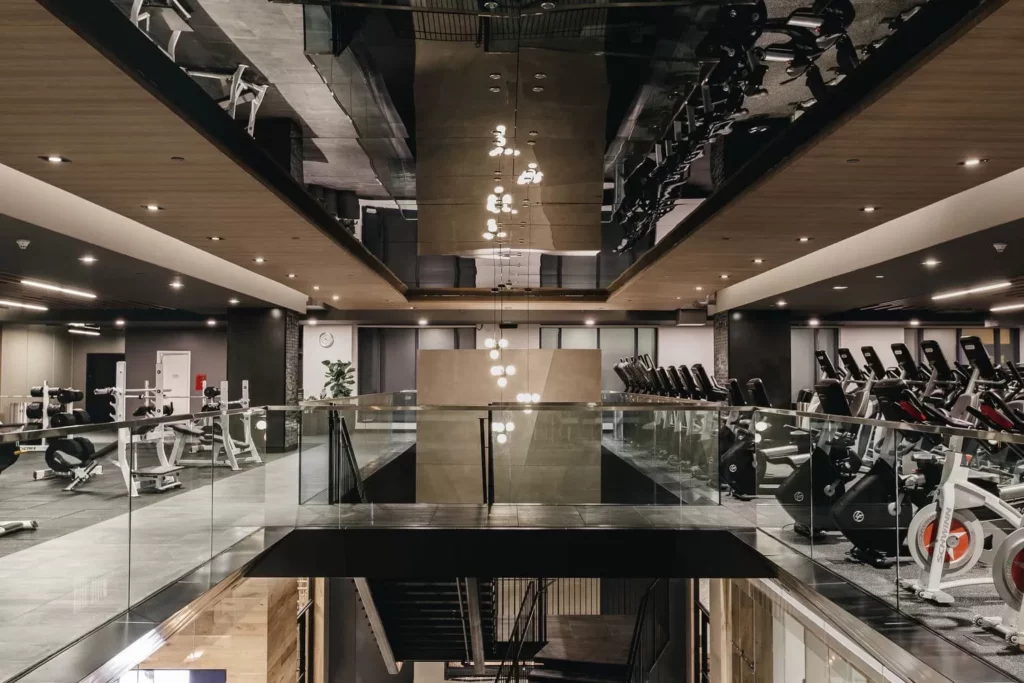
Discover innovative fitness center design ideas to astound and amaze your members while increasing revenue. Elevate your fitness center’s design aesthetic with our expert tips on brand identity, lighting, and much more.

Then elevate your gym’s software experience to match your top tier gym design. See why Exercise.com is the best gym management software platform to grow and manage your gym.
Want to learn more? Get a demo now!
Designing a Fitness Oasis: Commercial Gym Design Ideas for a Motivating Workout Experience

Big List of Commercial Gym Design Ideas
There are many different types of things to consider when embarking on a gym design quest. This is especially true if you are looking for inspiration to do a gym redesign, as you likely will only be able to afford focusing on certain categories of gym design ideas at a time. Here are some different types of gym design ideas for you to consider.
- Open Concept Layout: Create a spacious and open layout that allows for easy movement and flow within the gym.
- Natural Lighting: Incorporate large windows or skylights to maximize natural light and create a bright and welcoming environment.
- Mirrors: Install mirrors strategically to enhance the sense of space, provide visual feedback during workouts, and create a visually appealing gym aesthetic.
- Vibrant Colors: Use energetic and motivating colors on the walls, equipment, and flooring to create an engaging atmosphere.
- Functional Zones: Designate specific areas for different types of workouts, such as cardio zones, weightlifting zones, and stretching areas, to maximize efficiency and organization.
- Dedicated Strength Training Area: Create a dedicated space for strength training with power racks, barbells, and weightlifting platforms.
- Cardio Machine Cluster: Arrange cardio machines like treadmills, ellipticals, and stationary bikes in a cluster for easy access and a sense of community.
- Stretching and Mobility Area: Design a designated area with mats and foam rollers for stretching and mobility exercises.
- Group Exercise Studio: Set up a separate studio space for group exercise classes, equipped with sound systems, mirrors, and appropriate flooring.
- Functional Training Area: Create a functional training area with equipment like kettlebells, medicine balls, battle ropes, and suspension trainers.
- Sauna or Steam Room: Include a relaxation area with a sauna or steam room for post-workout recovery and relaxation.
- Lounge Area: Create a comfortable lounge space for clients to socialize, relax, and wait for their sessions.
- Upbeat Music: Install a quality sound system and curate motivating playlists to enhance the atmosphere and energize clients.
- Motivational Quotes: Display motivational quotes and inspiring messages on walls or digital screens to uplift and motivate clients.
- High-Quality Flooring: Choose durable and shock-absorbent flooring materials that provide comfort and support for various activities.
- Ample Storage: Incorporate ample storage options for gym equipment, accessories, and personal belongings to keep the space organized and clutter-free.
- Technology Integration: Integrate digital screens or TVs for displaying workout instructions, virtual training sessions, or live classes.
- Dedicated Changing Rooms: Provide dedicated changing rooms with lockers, showers, and amenities for convenience and privacy.
- Accessibility: Ensure the gym is accessible for individuals with disabilities, including wheelchair ramps, accessible bathrooms, and appropriate equipment.
- Greenery and Plants: Incorporate indoor plants to add a touch of nature and create a fresh and vibrant atmosphere.
- Innovative Equipment: Include cutting-edge fitness equipment that offers diverse workout options and engages clients.
- Custom Branding: Incorporate gym branding elements like logos, colors, and signage throughout the space for a cohesive and professional look.
- Hydration Stations: Install water stations or water fountains to encourage hydration and provide convenience for clients.
- Mind-Body Area: Designate a space for mind-body activities like yoga, Pilates, or meditation, with appropriate flooring and calming decor.
- Digital Fitness Tracking: Integrate digital fitness tracking systems to allow clients to monitor their progress and set goals.
- Multi-Purpose Space: Create a versatile area that can be transformed for different purposes, such as hosting events, seminars, or workshops.
- Suspension Training Zones: Set up suspension training systems like TRX straps in designated areas to offer clients a full-body workout option.
- Climbing Wall: Incorporate a climbing wall for a unique and challenging workout experience.
- Personal Training Pods: Create dedicated spaces for personal training sessions, equipped with necessary equipment and privacy.
- Retail Area: Allocate space for a retail area where clients can purchase fitness merchandise, supplements, or apparel.
- Outdoor Workout Area: Utilize outdoor space to create an outdoor workout area with equipment suitable for outdoor training sessions.
- Childcare Facilities: Offer onsite childcare facilities to cater to clients with children and provide convenience for busy parents.
- Recovery and Wellness Facilities: Include amenities like foam rollers, massage chairs, or cryotherapy equipment to support post-workout recovery.
- Functional Design Elements: Incorporate design elements that align with the gym’s theme, such as industrial, modern, or natural aesthetics.
- Technology-Enabled Equipment: Integrate fitness equipment with digital interfaces or connectivity options to enhance the workout experience.
- Gym Layout for Circuits: Design the gym layout with circuit training in mind, creating clear pathways for clients to move between stations.
- Safety Features: Install appropriate safety features like emergency exits, first aid stations, and clearly marked evacuation routes to ensure client safety.
Read More:
Introduction
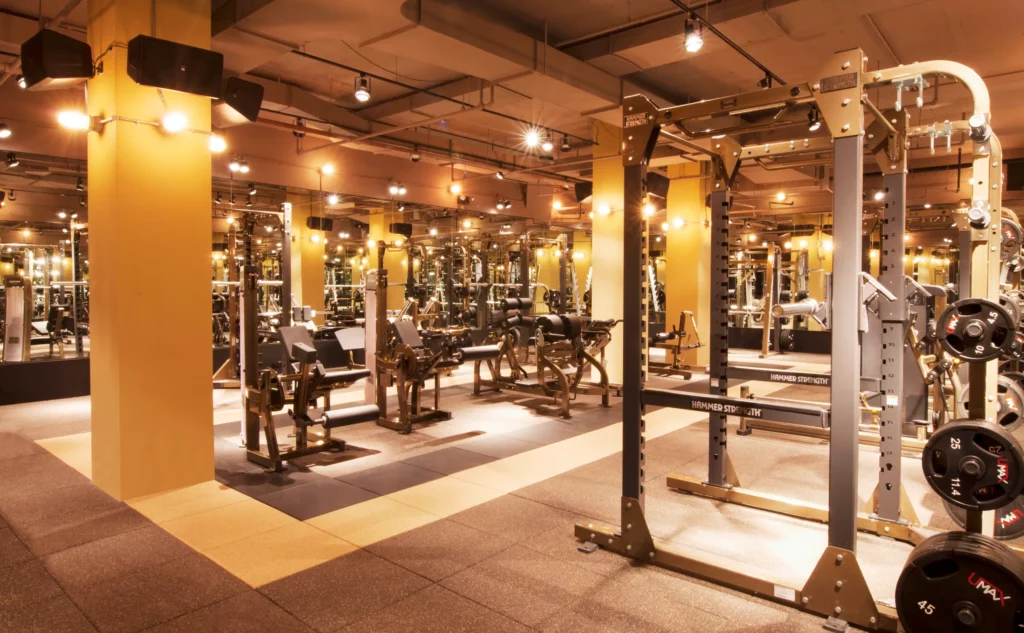
When it comes to commercial gyms, the design plays a crucial role in creating an inviting and motivating atmosphere. The design of a gym can make or break its popularity among potential clients.
Hence, gym owners must focus on creating an environment that promotes a positive attitude towards fitness. In the fast-paced world we live in today, the role of specialized fitness outlets is more important than ever.
Gym-goers prefer an environment that promotes health and well-being through aesthetically pleasing designs and curated facilities. A well-designed gym not only attracts new members but also retains existing clients by providing them with a comfortable setting to work out.
Importance of Gym Design for Commercial Gyms
The significance of gym design for commercial gyms cannot be overstated. A well-designed gym enhances client satisfaction by providing them with functional equipment and amenities that support their fitness goals while also stimulating their senses through the use of color schemes, lighting, and textures.
An effective gym design takes into account the psychological aspect of working out as well. It should create an atmosphere that boosts motivation, inspiration, and energy levels among members to keep them coming back regularly.
Read More: What is a commercial gym?
Brief Overview of Different Areas to Consider in Gym Design
Designing a commercial gym involves many areas such as space planning, equipment selection, flooring choices, lighting, color schemes, locker rooms/showers design considerations and technology integration. Space planning involves deciding how much floor space should be allotted for different workout machines based on anticipated usage patterns. Equipment selection needs to meet both safety requirements as well as functionality demands from members who come from different ages ranges with varying physical fitness levels.
Locker rooms and showers should be designed keeping in mind privacy concerns while making sure there is ample space provided along with clean water supply at all times. Lighting affects mood significantly; brighter lighting may encourage faster workouts while softer lighting could promote relaxation.
Color scheme can also be used to influence mood, with warmer colors such as orange and red stimulating energy levels and cooler colors such as blue and green promoting relaxation. In the following sections, we will take a deep dive into each area of gym design in greater detail and provide useful insights on how they can be optimized to create a fitness space that is both functional and aesthetically pleasing.
Read More:
- Commercial Gym Decoration Ideas
- Commercial Gym Storage Ideas
- Gym Entrance Ideas
- Commercial Gym Flooring Ideas
Space Planning
Importance of Space Planning in Gym Design
Space planning is one of the most important aspects of gym design for commercial facilities. A well-planned layout can make a space feel larger and more welcoming, while also maximizing the available space for equipment and members.
On the other hand, poor space planning can result in a cluttered and cramped gym that feels unwelcoming to members, ultimately leading to decreased usage. Additionally, proper space planning can help improve safety in the gym.
A layout that allows for easy movement between equipment and clear sightlines throughout the space can help prevent accidents or injuries. It is important to ensure that there are no obstacles that could create hazards, such as equipment too close together or obstructions near emergency exits.
Factors to Consider When Planning the Layout of a Commercial Gym
When designing a commercial gym, there are several factors to consider when planning its layout. First, it is essential to determine what type of equipment will be included in the facility and how much space each piece will require. This will help determine how much square footage needs to be allocated for each area of the gym.
It is also important to think about traffic flow through the gym. How many members are expected at peak hours?
How many people should be accommodated at any given time? Factors such as locker rooms placement near entrance/exit points should also be considered when determining traffic flow.
Another factor to consider when planning a commercial gym’s layout is accessibility for individuals with disabilities or injuries.These considerations may include wheelchair accessibility around machines or ramps construction if necessary. Overall, careful consideration should go into creating an efficient and effective layout designed with member safety & satisfaction in mind as well as functionality & productivity for staff (if applicable)
Equipment Selection
Types of equipment to include in a commercial gym

When it comes to selecting equipment for a commercial gym, there are several types that you should consider. Cardiovascular machines such as treadmills, ellipticals, and stationary bikes are always popular choices for gym-goers. Strength training equipment like weight machines, free weights, and resistance bands are also must-haves in any commercial gym.
It’s important to remember that different people will have different fitness goals and preferences, so having a wide range of equipment options available is crucial. Adding functional training equipment like kettlebells or suspension trainers can also be a great idea for those looking to improve their overall fitness level.
Other pieces of equipment that can be added to a commercial gym include rowing machines, stair climbers, and cable machines. Additionally, many modern gyms now include high-tech options such as virtual reality workouts or interactive workout screens.
Considerations when selecting equipment
While it’s important to have a variety of equipment options available in your commercial gym, there are other factors you should consider when selecting which pieces to invest in. Firstly, cost is always an important factor. Some types of exercise equipment can be quite expensive, so it’s important to create an accurate commercial gym budget before making any purchases.
Durability is also key; investing in high-quality pieces with sturdy frames and durable materials will save money on repairs or replacements down the road. Another consideration is functionality – what features does the piece offer?
Are they user-friendly? Do they require maintenance often?
Will staff know how to use them properly? Ensuring each piece serves multiple purposes can help make the most out of limited space while providing variety for members.
Some owners may want adjustable features on certain types of machines or amenities offered such as charging ports or drink holders for convenience purposes. Knowing your audience and what they expect in a gym experience can also help inform the equipment selection process.
When selecting equipment for a commercial gym, it’s important to consider cost, durability, functionality, multiple use cases and audience. By selecting high-quality pieces that offer variety and cater to the needs of different types of gym-goers, you can create an environment that promotes health and fitness for all.
Flooring
The flooring of a commercial gym is one of the most important aspects of its design. It not only affects the aesthetics of the space but also contributes significantly to the functionality and safety of the gym.
The right type of flooring can absorb shock, provide traction, reduce noise levels, and even enhance hygiene in a gym. Therefore, it’s essential to choose an appropriate flooring material that meets all these requirements.
Importance of Flooring in a Commercial Gym
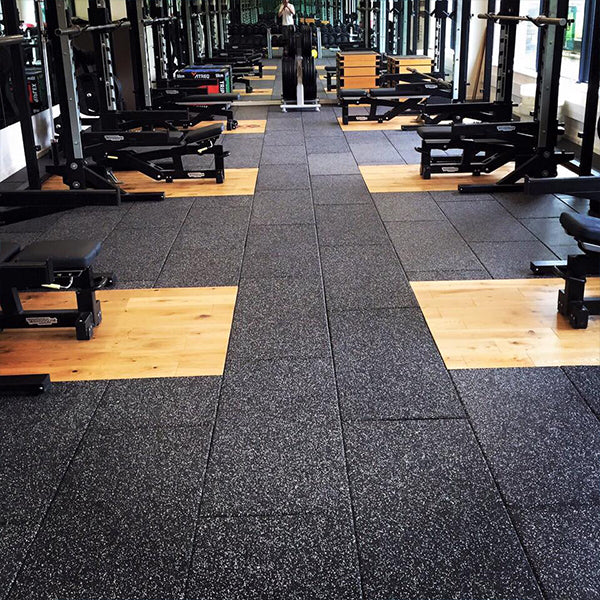
The flooring in a commercial gym should be carefully selected based on its durability and ability to withstand heavy foot traffic and wear-and-tear from equipment. A poorly chosen floor can result in costly repairs or replacements down the line. Fitness enthusiasts expect an environment that supports their fitness goals, which includes comfortable materials for cushioning their joints during high-impact exercises like running or jump training.
Moreover, choosing an appropriate material helps absorb sound and protect subfloors from damage caused by dropped weights or equipment movement. Beyond functionality purposes, flooring has a profound impact on how customers perceive your business’ brand image as well as their overall experience inside your facility.
Different Types Of Flooring Options Available And Their Benefits
There are various types of materials suitable for commercial gyms’ floors, each with unique features and benefits:
- Rubber Flooring: Made from recycled rubber tires, this versatile material is an excellent option for gyms that need durable floors capable of handling heavy weights without causing any damage to subflooring. It also provides excellent slip resistance and shock absorption while reducing noise levels.
- Vinyl Flooring: This synthetic material is water-resistant and easy to clean, making it ideal for facilities with high humidity levels like saunas or swimming pools. Vinyl flooring is available in different colors, patterns, and designs that can be customized to the gym’s branding and aesthetic preferences.
- Hardwood Flooring: Although expensive, hardwood flooring’s natural beauty and durability make it a popular choice among high-end gyms or fitness centers. It’s easy to clean and provides excellent shock absorption. Additionally, its warm tones create a welcoming and upscale atmosphere.
Selecting the right type of flooring in a commercial gym is crucial for creating an environment that promotes safety, functionality, and comfort. The above-mentioned materials are just some of the options available for gym owners to consider when designing their facilities.
Lighting: The Key to Setting the Right Mood
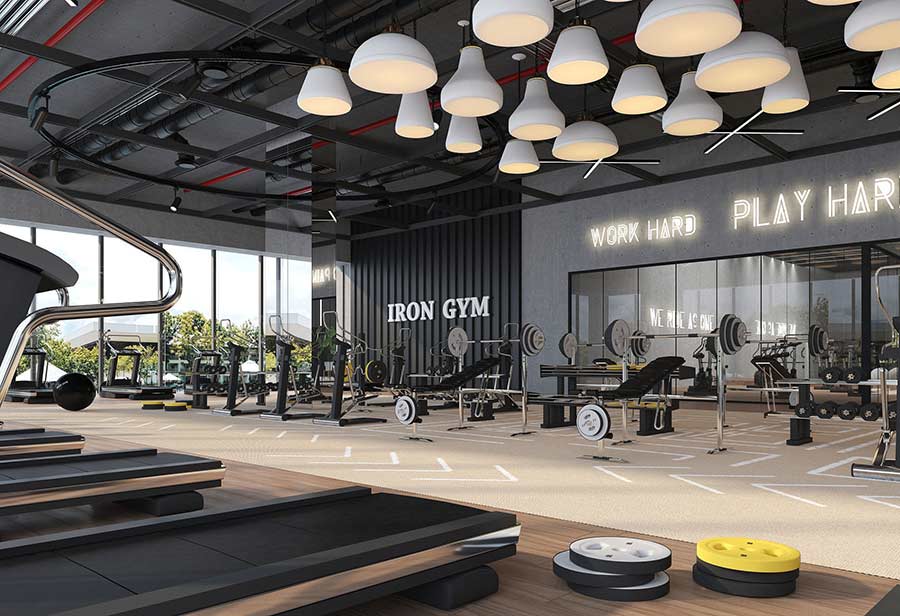
Lighting plays a crucial role in creating the right atmosphere in a commercial gym. It can help set the tone for a workout, enhance safety, and even impact mood and energy levels.
Different areas of a gym may require different lighting options, depending on their intended use. Here are some considerations when selecting lighting for your commercial gym:
Importance of Lighting in a Commercial Gym
The right lighting can make all the difference between an energizing workout experience and one that feels dull or uninspired. Properly lit spaces can improve focus, motivation, and even endurance. Well-lit areas also promote safety by reducing the risk of injury due to inadequate visibility.
In addition to practical considerations, lighting can also play an important role in creating atmosphere and branding for your gym. By customizing color temperature or brightness levels, you can convey your brand’s message while enhancing customer experience.
Different Types of Lighting Options Available and Their Benefits
There are several types of lighting options available to choose from when designing your commercial gym. Each has its unique benefits: – Fluorescent: This type of lighting is commonly used in gyms because it provides bright light at an affordable cost.
It is energy-efficient and long-lasting but has been criticized for its harsh white light. – LED: LED lights are becoming increasingly popular as they consume less energy than fluorescent lights and provide brighter illumination with less heat generation.
They are also known for their durability, making them ideal for high-use areas like gyms. – Natural Light: Nothing beats natural light when it comes to setting an inviting ambiance that promotes productivity and positivity among gym-goers.
When choosing your lighting options, consider these factors: color temperature (measured in Kelvins), CRI (Color Rendering Index), lumens (brightness), fixture type/shape, and the light’s direction. Proper placement of different types of lighting in your gym can help reduce shadows and enhance visibility.
Color Scheme
Choosing the right color scheme for a commercial gym is vital as it can significantly impact the energy and motivation levels of gym-goers. The color scheme should reflect the brand, ethos, and personality of the gym. A well-chosen color palette can evoke positive emotions, while a poor choice can have an adverse effect on overall mood and productivity.
Importance of Color Scheme in a Commercial Gym
Colors have a powerful psychological influence on people, affecting their moods, emotions, and behaviors. In commercial gyms, colors that promote energy and motivation are essential for creating an environment that inspires people to work out.
Studies show that brighter colors such as reds, yellows, oranges can help increase heart rate and stimulate brain activity. On the other hand, calming colors such as blues or greens may promote focus during yoga or mindfulness sessions.
In addition to promoting positive emotions in gym-goers, selecting a cohesive color scheme that complements brand identity will take your commercial gym to another level of professionalism. A consistent look throughout your space creates an inviting atmosphere for customers with memorable branding.
Tips For Selecting Colors That Promote Energy And Motivation
While choosing a suitable color scheme for your commercial gym requires careful consideration based on individual needs and goals here are some tips to guide you: 1) Keep it simple – Start by selecting two or three main colors which complement each other well: one primary bright hue (such as red), one secondary neutral tone (such as gray), then consider adding pops of accent colors for visual interest.
2) Use bright hues wisely – Bright hues like yellow or orange are great for accent walls but might be too overpowering across all walls in large spaces. 3) Balance with neutrals – Neutrals like gray help balance bright hues while helping create depth and add sophistication to space.
4) Consider your Brand – Your brand identity should be properly represented in the color scheme you select. Match the colors to the branding guidelines to ensure consistency in how people interact and perceive your facility.
5) Test before committing – Before making a final selection, consider purchasing small samples of each color to test out their application on a wall or floor space. It’s essential to see how different lighting, flooring, and equipment might impact color choices.
Read More:
- Commercial Gym Lighting Ideas
- Commercial Gym Layout Ideas
- Commercial Gym Mirror Ideas
- Commercial Gym Organization Ideas
- Commercial Gym Wall Ideas
- Gym Whiteboard Ideas
Locker Rooms and Showers: Design Considerations for a Commercial Gym
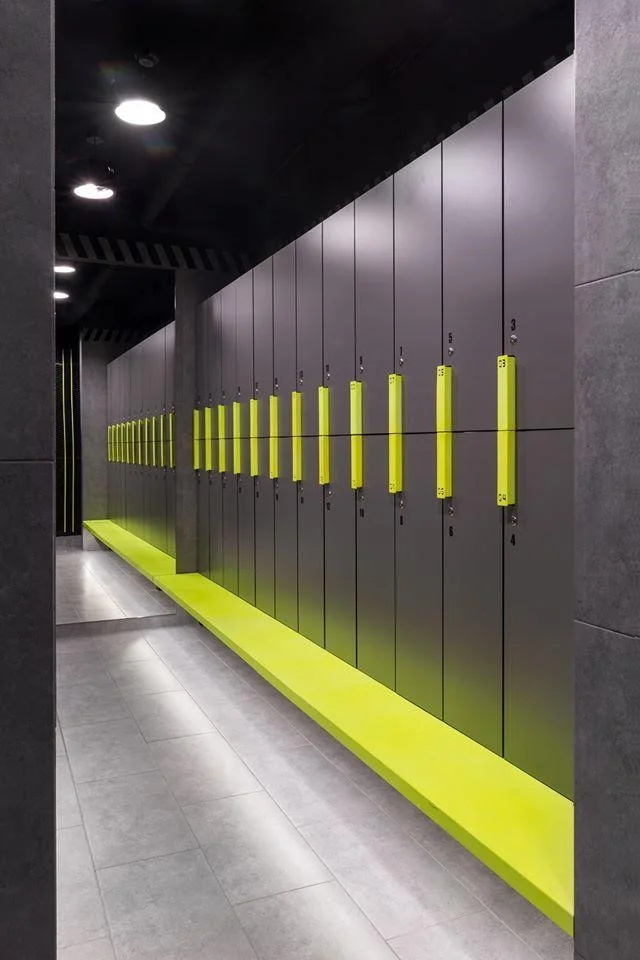
The locker room and shower area is an essential part of any commercial gym. Members will spend time before and after their workout in this space, making it important to create a welcoming and comfortable environment. Proper design considerations are necessary to ensure that the locker room and shower area meet the needs of your members while also being practical for your gym’s operations.
Layout and Space Planning
The layout of a locker room can be critical to its functionality. When designing a locker room, it’s important to ensure there is enough space for lockers, benches or seating areas, showers, toilets, sinks, mirrors, and other amenities that members may need.
The layout should also allow for adequate circulation space between these areas so that members can move around comfortably without congesting certain areas. In terms of materials used in the locker room’s design composition – water-resistant materials such as porcelain tiles or natural stone tiles are recommended as they are durable enough to withstand constant exposure to moisture while still being easy to clean.
You can also use glass partitions around showers or vanity areas if you’re looking to create some privacy within an open-concept locker room design plan. With regards to lighting – dimmers installed should provide maximum control over your lighting as it enables users to adjust the light as per preference.
Fittings & Amenities
The fixtures used in a commercial gym’s locker rooms should be sturdy enough as they need frequent use while still being aesthetically pleasing. Selecting high-quality fittings such as taps with touchless sensors instead of traditional knobs will reduce cross-contamination risks – reducing potential health risks within the facility. Ensure there’s ample storage space so that patrons can store their belongings when using amenities provided by gym facilities such as towels etc., which reduces clutter and overall space required within the locker room.
Adding a sauna or steam room is also an option if you’re looking to provide a relaxing post-workout experience for your members. Amenities should be considered when designing a commercial gym’s locker room, ensuring that the needs of all gym-goers are met.
Basic amenities such as hairdryers, mirrors, hand sanitizers and ample towel dispensers are necessary for any gym-goer. You can take it further by providing luxury amenities such as plush seating areas, phone chargers or even vending machines within a locker room for added convenience.
The locker room and shower area is an essential part of any commercial gym design plan. Proper design considerations can help you create a welcoming and comfortable environment that meets the needs of your members while also being practical for your gym’s operations. By creating an aesthetically pleasing space that provides basic amenities as well as luxuries, patrons will feel more inclined to use your facilities often – increasing both overall patronage & retention rates.
Technology Integration
The Role of Technology in Modern Gyms
Technology has significantly transformed the fitness industry over the years. With the rise of smartphones, wearable tech, and other digital gadgets, gym-goers expect more than just weights and cardio machines.

With the Exercise.com platform, you can grow and manage your entire gym in one central place. Book sessions, schedule classes, conduct gym check-ins, deliver online training, sell workout plans, run fitness challenges, and more—all from your own custom branded fitness apps.
Want to learn more?
Technology plays an essential role in modern gyms to enhance members’ experiences, improve safety measures, and attract new customers. One technology integration that has become increasingly popular is audio systems.
High-quality sound systems can make a big difference in a gym’s atmosphere, creating an energetic environment that motivates people to work out harder and longer. In addition to traditional speakers that play music throughout the gym, many gyms now offer individual entertainment options like Bluetooth headphones or TV screens on cardio machines.
Interactive Screens
Interactive screens have also become a popular technology integration in gyms as they allow users to access various types of resources such as workout routines and exercise demonstrations. These screens provide an engaging experience for members while providing them with guidance on exercises they may not be familiar with or correcting their form. Some interactive screens are also designed to offer personalized workout programs based on user data-driven insights.
Another use for interactive screens is virtual reality (VR) equipment that transports users into different environments as they exercise. This technology allows users to interact with workout programs through simulations of activities such as rock climbing or boxing.
Fitness Tracking Apps
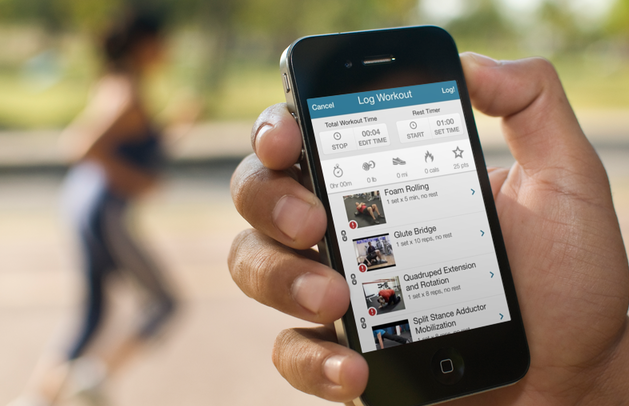
Fitness tracking apps are ubiquitous today and have led to one of the most significant technological advancements in modern gyms by allowing gym-goers to track their workouts’ progress digitally. Fitness tracking apps provide users with valuable data about their workouts’ intensity levels which helps monitor their progress towards fitness goals like weight loss or strength gain.
Read More:
- Best Fitness App Builder Software
- How to Make a Fitness App
- How do I monetize my fitness app?
- Best Gym Mobile Apps Software
- How much does it cost to make a fitness app?
Many commercial gyms now integrate these apps into their equipment (or provide compatible mobile devices) so members can keep track of their workouts using heart rate monitors, step counters, or other sensors. These apps also often offer gamification features that allow users to compete or collaborate with others, making workouts more fun and sociable.
Want to get your own custom branded fitness apps?
Take Your Gym Technology Stack to the Next Level
The integration of technology in commercial gym design is an exciting development for the fitness industry. By leveraging cutting-edge technology, gyms can provide members with engaging workout experiences that help them achieve their fitness goals.
With interactive screens and other digital tools at their disposal, gym-goers have access to a wealth of resources that can improve their exercise routines and motivate them to continue working out long-term. Ultimately, technology integration in commercial gym design offers significant benefits for both gym owners and members alike.
Safety Measures
The importance of safety measures within the design plan.
When designing a commercial gym, one of the most important considerations is safety. A gym is a place where people come to exercise and push their limits, and accidents can happen if proper safety measures are not in place.
Therefore, incorporating safety features into the design plan should be a top priority. For example, emergency exits should be clearly marked and easily accessible from all areas of the gym.
In case of an emergency such as a fire or earthquake, gym-goers should know exactly where to go and how to get there quickly and safely. It’s also important to ensure that there are enough exits for the number of people in the gym at any given time.
Examples such as emergency exits, first aid kits.
Another important safety measure is providing first aid kits throughout the gym. Accidents happen when people are exercising, and having first aid supplies readily available can make all the difference in treating minor injuries before they become more serious. First aid kits should include basic supplies such as bandages, gauze, antiseptic wipes, and gloves.
Additionally, it’s important to have staff members trained in CPR and first aid on site at all times during operating hours. This will ensure that there is always someone available who knows how to respond to emergencies quickly and effectively.
Incorporating safety measures into your commercial gym design plan is crucial for creating a safe environment for your clients or members. From emergency exits to first aid supplies and trained staff members, every detail matters when it comes to keeping everyone safe while working out. By prioritizing safety during the design process, you can create a space where people feel comfortable pushing their limits while also knowing that they are protected in case anything goes wrong.
How can I create an open and spacious layout in my commercial gym?
Creating an open and spacious layout in your commercial gym can be achieved by strategically arranging equipment and creating designated zones for different workout areas. Consider the flow of movement within the space, ensuring that there is enough room for clients to navigate comfortably. Use modular and adjustable equipment that can be easily rearranged to accommodate different types of workouts and class sizes. Additionally, incorporating large windows or skylights can maximize natural light and create a sense of openness.
What are some key factors to consider when choosing gym flooring for my commercial gym?
When choosing gym flooring for your commercial gym, it is important to consider factors such as durability, shock absorption, traction, and maintenance requirements. Opt for flooring materials that can withstand heavy equipment and high foot traffic while providing sufficient shock absorption to reduce the risk of injuries. Non-slip surfaces are essential to ensure safety during workouts. Additionally, choose flooring that is easy to clean and maintain to uphold hygiene standards in your gym.
How can I create a motivating and energizing atmosphere in my commercial gym?
Creating a motivating and energizing atmosphere in your commercial gym starts with the right combination of lighting, colors, and music. Utilize bright and energetic colors on the walls and equipment to create a vibrant environment. Install high-quality sound systems to play motivating music that matches the intensity of workouts. Consider incorporating motivational quotes or inspiring messages on walls or digital screens to uplift and motivate clients during their workouts. Proper lighting, both natural and artificial, can also contribute to the overall atmosphere and enhance the energy of the space.
How can I optimize the use of space in my commercial gym?
Optimizing the use of space in your commercial gym can be achieved through smart equipment selection, efficient storage solutions, and thoughtful layout design. Choose equipment that offers multiple functionalities and can be easily adjusted or folded to save space. Utilize vertical storage options, such as wall-mounted racks or shelving units, to maximize floor space. Implement a well-thought-out layout that allows for clear pathways, functional zones, and dedicated areas for different types of workouts. By maximizing the use of available space, you can ensure a comfortable and efficient experience for your gym members.
How can Exercise.com help with the design and layout of my commercial gym?
While Exercise.com does not offer commercial gym design services, we do offer a comprehensive software platform that can assist you in optimizing your commercial gym’s performance. With our gym management software, you can benefit from our scheduling and booking features, workout delivery, fitness challenge, online fitness group, gym check-in, door management, workout logging, custom branded fitness apps, and more—which allow you to efficiently manage class schedules and optimize space utilization.
Get Started

Ready to get started taking your gym to the next level? See how the Exercise.com platform can help you grow and manage your gym better?









